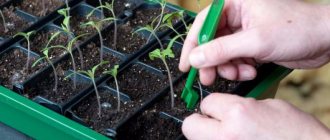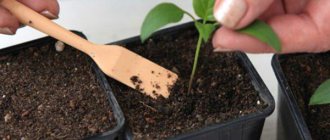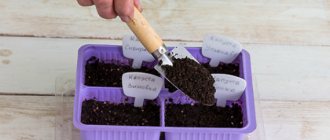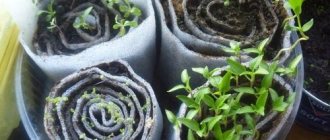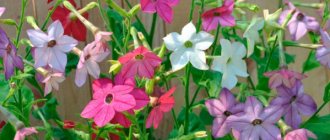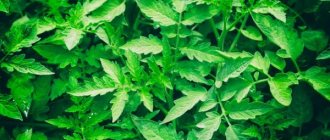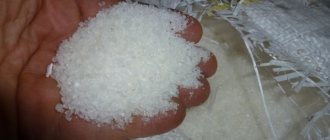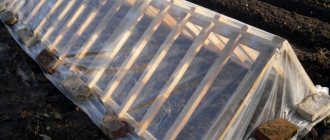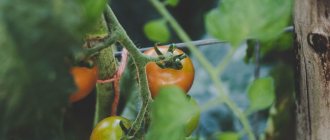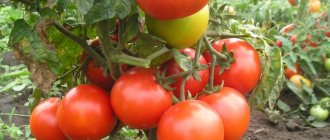Literally every gardener has formed his own opinion on picking issues. Some people pick up all seedlings without restrictions, some carry out this procedure selectively, and some even consider it the root of all seedling disasters.
It is clear that it is not easy to allocate a separate pot for each germinated seed, and there is not much space in an ordinary apartment. However, the problem with picking is that inexperienced summer residents often carry it out with errors or do it completely wrong and are upset by the results obtained. To prevent this from happening in the future, you need to figure out what picking is, how to do it correctly, and which plants need it, and which will grow better without it.
Picking seedlings - what is it and when is it necessary?
Picking is the transplantation of seedlings from a container common to all seedlings into individual pots, accompanied by truncation of the main root of the plant by 25-30% of its length. The operation is carried out using a special instrument - a pointed peg, which in French is called a “piquet”. From this word comes the name of this activity for caring for seedlings - picking.
The need for picking is the subject of much debate. Some gardeners believe that this event is mandatory for any seedling. Others have a different opinion, saying that picking is too much stress for seedlings, reducing their growth rate. Let’s try to bring a little more clarity and cite both the advantages of this operation and its controversial issues. So, the positive aspects of picking include the following.
- Providing more space for seedlings to grow . At the beginning of cultivating seedlings, seeds of ornamental and vegetable crops are planted in a common container - there it is easier to provide them with normal drainage and allow them to hatch as quickly as possible. But after a while, the seedlings will begin to interfere with each other - there will be not enough space and nutrients in the container for everyone. Picking solves this problem - each plant receives an individual pot or glass and a sufficient amount of substances necessary for further development.
- Sorting of seedlings. For its cultivation, seedlings require a place on a windowsill under the sun or a phytolamp, soil and fertilizers, watering and care. And it is undesirable to spend your time, effort and money on those plants that for some reason will not be able to develop normally and produce good, abundant and high-quality fruits. During picking, you can cull - select and transplant only the healthiest and most viable seedlings into individual containers.
Prices for phytolamps
But there are also two controversial points about picking. The first is that for insufficiently healthy seedlings, replanting is a serious stress, which can cover up all the benefits associated with individual growth capacity and stimulating the development of lateral roots. The second controversial point about picking is that it is not best suited for plants with a taproot system. Therefore, for such crops, it is better to limit yourself to simply transplanting seedlings from a common container into individual glasses or pots.
Important! The timing of the picking is of great importance. If done too early, the stress that accompanies root truncation and replanting can destroy the plant or seriously impede development. But if the right moment was missed, then the seedlings in the common container begin to intertwine their roots with each other, and it will become very difficult to dive them without severe damage. Choose to work at a time when the seedling has two true, non-cotyledon, leaves.
Suitable container and soil
Ageratum is compact in size; its seedlings also do not grow large. Taking this into account, you can sow in a common container. The container should be wide, with low sides and drainage holes in the bottom. For this purpose, you can use a plastic container, cassette containers, a tray for semi-finished products or sweets.
The culture is considered unpretentious; any soil that contains nutrients and has a loose structure is suitable for it. You can purchase ready-made soil called “Universal” or “Flower” at a garden store. If you need a lot of seedlings, gardeners prepare their own land to save money. Peat, sand and humus must be added to garden soil.
Purslane seedlings: 6 useful growing tips
Vermiculite can be used instead of sand. The mixture must be steamed in a microwave, oven or water bath to destroy fungal spores, bacteria and pest larvae. Disinfection is carried out 10-15 days before planting; the soil microflora must be given some time to recover.
Arguments for and against picking seedlings
Picking seedlings is one of the controversial issues, and discussions around it will probably never end. Why? Yes, because both supporters and opponents of this procedure rely not only on theoretical knowledge, but also on their own practical experience. But what about those who are taking their first steps in gardening and gardening?
Picking seedlings is one of the controversial issues
Let's try to evaluate the advantages and disadvantages of the method, look at it from different angles - perhaps then it will be easier to decide whether your plants need picking or whether it is better to do without it.
Watering after picking
So that the soil fits tightly to the roots and there are no voids left in it, it is completely soaked. If the seedlings are large enough, then water the soil as usual - from above. Plantings with small seedlings that are easy to wash away are placed in a tray with water until the ground is saturated with moisture, and the top is generously moistened with a spray bottle. If seedlings from crops affected by blackleg have been picked, a fungicide (for example, Maxim) is added to the water.
watering picked seedlings
What is seedling picking?
This term comes from the French word piquet , meaning “ stake , peg ”. As a rule, it refers to the transplantation of young plants (seedlings) from a common container into separate pots. Sometimes picking is also called pinching the tap root during transplantation - this is done to force the root system to branch.
Picking is a traumatic procedure for plants
Thus, the reason for doubt becomes clear from the definition: picking is a traumatic procedure, interference in the processes of growth and development of seedlings. Of course, this raises numerous questions to which we will try to find an answer.
Answers to frequently asked questions
What to do if the seedlings wither after picking?
Answer: Temporary wilting of leaves should not be scary. This happens if the root system is shortened more than necessary. Feeding with growth stimulants can help the plant recover.
Is it possible to avoid picking when growing petunia?
Answer: Without picking, plants develop more slowly. Their root system is weaker and is not capable of ensuring the full formation of the bush. As a result, fewer flower buds are produced.
After transplantation, petunia seedlings experience a slowdown in development. What could be the reason?
Answer: A slowdown in growth can be observed with strong temperature fluctuations during the day. Hot sunlight can also have an effect.
Can all crops be picked?
Most plants (both vegetable and ornamental) tolerate picking well when done correctly. But there are crops that it is advisable not to disturb - their root system reacts painfully to any intervention, and even if the seedling does not die after the procedure, it will noticeably lag behind its peers in development.
Such “touch-me-nots” include, for example, cucumbers, zucchini, pumpkins - it is better to sow them immediately in a permanent place or, as a last resort, grow them in peat pots, with which they are then “relocated” into the ground. Although someone is picking these plants too.
Cucumbers, zucchini and pumpkins are “touchy”, they don’t like picking
But tomatoes, beloved by summer residents, on the contrary, after properly carried out picking, become noticeably stronger, build up the root system and form strong, well-developed bushes. The following short video very clearly shows the differences in the development of tomatoes grown with and without picking:
There are conflicting opinions about picking eggplants and peppers. Some say that you can’t pick them, because the plants then get sick for a long time, others argue that the procedure only benefits these crops. From my own experience, I can say that pepper tolerates picking very well - cases of plant death or disease after transplantation are rare. At the same time, contrary to recommendations, I bury the seedlings when picking and carry out the procedure very early, without waiting, as all sources advise, for the first true leaves to appear.
And here is what Sergey Dubinin, founder and CEO of Agro, says about this:
It turns out that you can dive almost all crops if you do it correctly and on time.
At what age should seedlings be picked?
It is recommended to pick when the plant has formed 1-3 true leaves (they must be distinguished from cotyledons, which appear immediately as soon as the sprout emerges from the soil). This usually happens 2-3 weeks after germination. It is possible to dive earlier, but later it is undesirable. The older the seedlings become, the more difficult it is to tolerate the procedure.
The older the seedlings become, the harder they tolerate picking
Here it is worth considering one more nuance: when the plants are sown in a common container, and there is little free space between them, as they grow, they begin to interfere with each other. The seedlings stretch out, the stems become thin, the roots intertwine underground, and it will be very difficult to avoid injury during transplantation. Therefore, the sooner we pick, the easier it is for the seedlings to take root in the new place.
When to pick petunia in 2022 according to the lunar calendar, favorable days
Many gardeners prefer to carry out the picking procedure on favorable days of the Lunar calendar.
It is recommended to pick petunia during the waxing lunar phase. The best period will be those days when the moon is in the constellation Virgo.
The table below contains data on recommended picking times.
| Month | Better days | You can dive |
| February | 18 | 5, 6, 7, 8, 9, 10, 11, 12, 13, 14 |
| March | 16, 17 (first half of the day) | 4, 5, 6, 7, 8, 9, 10, 11, 12, 13, 14,15 |
| April | 13, 14 | 3, 4, 5, 6, 7, 8, 9, 10, 11, 12 |
| May | 10, 11 | 2, 3, 4, 5, 6, 7, 8, 9, 12, 13, 14 |
Is it necessary to bury seedlings when picking?
To obtain stronger and stockier plants, when picking, seedlings are buried almost to the cotyledon leaves.
When picking, seedlings are buried almost to the cotyledon leaves.
The exception is pepper. It is believed that he reacts painfully to deepening; Moreover, this culture does not form adventitious roots; the seedlings, even in cramped conditions, do not stretch particularly - there seems to be no need to bury them.
Picking is important for plants that are sown superficially (petunias, lobelias and others). If you nevertheless decide to grow these crops without picking, pour the soil for sowing into a container in such a way that you can later add soil, burying the seedlings with bedding. And read the notes based on practical experience:
- Petunias: grow with or without picking?
- Petunias. To new apartments, or Why picking, transshipment, transplantation is needed
Sowing scheme
Before sowing, a small drainage is placed at the bottom of the container and a layer of prepared soil is poured, not reaching the edge 2-3 cm. The soil is spilled in advance so that it is moderately moist. Then the seeds are spread over the surface of the soil using tweezers. Ageratum planting material is quite small.
The seeds are distributed over the surface at intervals of 1 cm. Sowing of ageratum should be superficial, the seeds are only slightly pressed to the ground. Then the soil is sprayed and covered with a transparent lid or film to create a moist environment under the shelter.
What is the benefit of diving?
Let's summarize: what arguments can be given in favor of picking seedlings?
1. This method allows you to select the strongest and most viable plants , which in the future will give a good harvest or delight you with abundant, beautiful flowering.
2. Picking helps save space : at the initial stage, seedlings fit in one small container. With the non-pick method of growing seedlings, we will be forced to use sparse sowing or thin out the seedlings.
Picking helps save space
3. Pinching the main root stimulates the formation of a powerful branched root system , which will help the plant receive more nutrition in the future.
4. After picking, the plant receives additional nutritional area. If suitable size planting containers and high-quality soil are used, this becomes a good incentive for the development of seedlings .
5. Some crops (for example, tomatoes) require picking: it helps to form strong, healthy and stocky seedlings .
To plant seedlings, you will need planting containers, soil, tools... You will find all this and much more that a summer resident needs during the crucial period of growing seedlings in our catalog, which combines offers from various online stores. Select everything you need for seedlings.
Features of the procedure
From a botanical point of view, picking is the separation of certain parts of the root system to ensure the desired root growth. However, among summer residents this term has a slightly different meaning and is a common procedure that is used for seedlings and involves transferring seedlings from small pots to larger containers. At the same time, new pots are filled with new fresh soil. This procedure is very controversial. Some gardeners claim that picking is harmful to seedlings, disrupts metabolic processes in the cells of seedlings and slows down plant growth. Others are confident in the benefits of the procedure. Which opinion is correct and is it really worth picking seedlings?
How can diving harm plants?
What reasons encourage summer residents to refrain from picking? Most often - your own negative experience or fears. Indeed, an unsuccessful procedure can destroy plants. Let's see what serious mistakes can lead to similar consequences.
An unsuccessful procedure can destroy plants.
Mistakes that are most often made when picking
1. They forget to prepare the plants for the procedure. The main thing is to moisten the soil abundantly in order to injure the roots as little as possible. By pulling seedlings out of dense, dry soil, we are more likely to damage them.
2. Bend the roots when planting. If the root of a plant is too long, it is better to pinch it, stimulating the formation of additional lateral roots, than to “pack” it into the planting hole by folding or bending it. Incorrect root location will lead to problems in the growth and development of the seedling.
3. They forget about post-transplant care . In the first 2-3 days after the procedure, picked seedlings need special care. They need to be protected from the sun and watered properly (rarely, but abundantly). Sometimes it is recommended to use rooting stimulants to help plants take root faster.
Weakened, damaged, diseased, deformed plants dive . There is a high probability that they will not survive the transplant. It is advisable to discard such seedlings; if the number of seeds is too small, it is better to prefer the non-pick method of growing seedlings.
Diving is a rather labor-intensive process
In addition, diving is a rather labor-intensive process that requires patience and accuracy. Of course, there is a great temptation to save your own time by sowing plants directly into separate cups or other containers.
What is right? Through trial and error, each summer resident comes to his own answer to this difficult question. I hope our conversation today helped some of you make up your mind and find your solution. Share your opinions in the comments: in your opinion, is picking necessary when growing seedlings or is it better without it? Why?
If you want to know the opinion of professionals about growing vegetables, come to our Gardener Academy . Agrofirm Search specialists, who teach classes and answer students’ questions, will help systematize existing knowledge and learn a lot of new, useful information. The upcoming lessons are dedicated to growing seedlings.
When picking petunia in 2022 according to the lunar calendar is not desirable, unfavorable days
It is better not to pick petunias and other flowers when the Moon is in the Full and New Moon phases.
Days when the moon is in the signs of Aquarius and Pisces are also considered bad times.
Thus, do not dive:
- February – 1, 2, 3, 4, 15, 16, 17, 28.
- March – 1, 2, 3, 17, 18, 27, 28, 29, 30, 31.
- April – 1, 2, 15, 16, 17, 23, 24, 25, 26, 27, 29, 30.
- May – 1, 15, 16, 17, 21, 22, 23, 24, 29, 30, 31.
ON A NOTE. Picking on the waning moon is also not recommended, but if there is no other choice, it is allowed.
Pros and cons of picking
Let's first consider the advantages of picking:
- Thanks to picking, there is no need to thin out the seedlings. The procedure helps to weed out weak and defective shoots at an early stage, and allow strong and healthy samples to be grown.
- Picked plants quickly take root in open ground, take root easily and without problems, and are characterized by lasting health and increased productivity.
- The root system of pickled plants is located in the top layer of soil, heated by the sun. The root system is not afraid of frosts and fluctuations in air temperature.
Although the last advantage can also be a disadvantage of picking. A pinched main root is unable to grow deep into the ground and take water from there during periods of extreme heat. The plant needs attention and careful regular watering. Another disadvantage of picking is the small percentage of plant death after the procedure. The fact is that transplanting seedlings is stressful for the plant; the risk that it will not take root in a new place always exists.
Features of correct plant picking
- Do not deepen the plant beyond its growth point, as its development may slow down or even stop.
- Plants must be replanted immediately after two cotyledon leaves emerge. Many gardeners are in no hurry to replant seedlings for fear of damaging too fragile stems, thereby doing them a disservice. The fact is that the younger the seedling, the faster it adapts after picking and strengthens its roots before transplanting into open ground. Accordingly, in the vegetable garden or flower garden there will be less pain and faster development.
- Before planting in a separate pot, it is advisable to disinfect the plant roots in a weak solution of potassium permanganate (1 gram of potassium permanganate per liter of water). Why disinfect plants? Tiny seedlings are too weak to cope with bacteria on their own, so disinfection is a necessary step when picking plants. To avoid infection with rot or fungal diseases, it is necessary to disinfect the roots.
- Do not fertilize the plants until the seedlings begin to grow together. Aging is approximately 6-8 days from the date of picking. Why? After picking seedlings, the seedlings experience a state of shock, so do not try to apply fertilizers immediately after the picking session, let the small sprouts get used to it, adapt to new, freer conditions, and after that you can apply the fertilizers recommended for these purposes.
Seedling picking techniques
Before starting the procedure, prepare the necessary details. You will need:
- Tray with seedlings;
- Individual containers (it is convenient to use plastic cups);
- Priming;
- Picking stick (peg, fork, pencil or toothpick);
- Water.
Immediately before starting work, water the seedlings and wait a few minutes for the water to drain. There are 3 methods of picking seedlings.
- Picking seedlings under a peg. Using a stake, make depressions in the soil into which you are replanting the plants. It is better if these are individual containers. If there is only one container for the entire seedling, leave a space of 10x10cm for each seedling. Use a peg to make a hole next to the seedling, carefully tilt the peg to lift the seedling along with the soil. Hold the seedlings by the cotyledon leaves; holding them by the stem is dangerous as it may break. Pinch the main root of the seedling, move it to a new place, and deepen it to the level of the first leaves. Use a stake to straighten the roots and carefully fill the hole with soil, lightly pressing the soil at the base of the stem.
- Picking seedlings under your finger. The procedure in this method is similar to the first, the only difference is in the working tool. Use your index finger instead of a diving peg. The depth of the pits is equal to the length of the index finger. The method is fast; without additional tools, the work is done several times faster.
- Picking seedlings under the plank. The method is used when there are large volumes of work, 15-20 seedlings are picked at the same time. The downside of this method is that it reduces the quality of the picking. Make a groove in the ground and water it. Place the seedlings with the peaked main root in the furrow at a distance of 5-10 cm from each other. Using a wooden plank, move the soil, covering the roots of the seedlings in one motion.
How to prepare for a pick
Purchase in advance all the necessary tools, materials and equipment for growing seedlings. When transplanting seedlings you will need:
- individual planting containers, the size of which depends on the type of crop (the diameter of the pot for salad is about 5 cm, for cruciferous crops - 5-7 cm, for nightshade plants - from 8 to 12 cm);
- soft water, for example, rain, melted water, filtered or, in extreme cases, standing for at least three days, for subsequent watering from a syringe and a spray bottle with water;
- a solution of any effective rooting agent, prepared in accordance with the instructions, for example, “Grandis” or “Clean Sheet”;
- fertile, loose and well-structured soil, for example, “Universal substrate for seedlings of vegetables and flowers based on lowland peat with neutral acidity of about 6.5 pH”;
- a diving fork or a wooden stick with a rounded end;
- a rounded peg, the diameter of which depends on the size of the root system, with which planting holes will be made, for example, when transplanting grown petunias, it is more convenient to use a file handle, and holes for thin tomato stems can be made using a pencil;
- marking pegs for inscriptions of varieties (optional).
The use of rooting agents after transplanting seedlings reduces the risk of poor survival and stimulates growth
How to pick seedlings correctly
- Fill each pot with slightly damp soil from a bag and tamp the soil down lightly with your fingers.
- Using a wooden stick, make a hole in the soil in the center of the cup.
- Place all the planting containers on one side, and the common container with seedlings on the other. The number of pots, cassettes, bags or cups should approximately correspond to the number of seedlings.
- Having placed a tray or other container with seedlings in a convenient place, begin to remove the sprouts from the edge of the box, carefully lifting the soil with a fork, spoon or stick. At the same time, choose areas of soil near the edges and between plants to minimize damage to already quite long roots.
- After the seedling is removed from the ground and its thin roots are clearly visible, the lower part of the central rod must be pinched with the middle and thumb a third of the length, holding the bush by the stem. Pinching stimulates root branching due to the development of lateral shoots.
- Some plants do not pinch when transplanting, for example, petunias and all pumpkin plants. They are transferred to a new place in the hole along with a lump of earth enveloping the root system. The roots of all plants grown in peat tablets should not be cut. In such a substrate, the roots feel comfortable and respond well to moving into a larger volume of soil mixture.
- Place the seedling in the hole. Digging down to the cotyledon leaves is carried out in cases where the seedlings have become elongated due to overexposure and lack of light. In other situations, the sprouts are buried at the same level as they grew.
- Using your fingers, carefully fill in the space around the seedling. Do not overdo it so as not to completely block air access to the roots.
- Place markers in containers if you want to know exactly which variety or hybrid is which.
- Immediately after planting and installing containers on window sills or shelves, water them with a rooting solution at room temperature from a large syringe or syringe. Additionally, spray the seedlings from a spray bottle (lightly) with the same solution. Using a drug with growth-stimulating and root-forming properties, you will not only improve the conditions for the development of the root system, but also minimize planting stress.
Even if you are new to gardening, do not be afraid to make a pick - first, try replanting tomatoes, they can easily cope with stress and do not need extraordinary manipulations
Also watch Olga Pavlovna Chernova’s video about the main mistakes when picking:
Tips for gardeners and gardeners
To avoid making mistakes when picking seedlings, use the advice of experienced gardeners and gardeners.
- The timing of picking seedlings depends on the seedlings. 2-3 weeks after the emergence of seedlings at the stage of 2 true leaves, it is customary to pick. Do not confuse the true leaves of the future plant with the cotyledons, which appear first on hatching seedlings. Take your time, but don’t delay: the younger the seedlings, the easier it is for them to adapt to a new place.
- Leave the plant's growing point at ground level, or deepen it 0.5 cm below. Left on the surface, it will cause the plant to stop growing.
- Before planting seedlings in a new location, disinfect the roots in a weak solution of potassium permanganate.
- After picking, water the seedlings and take them to a cool, shaded place for 5-7 days. Then return to the windowsill and resume standard care.
Picking seedlings is a necessary and important stage in the life of a plant. The advantages of picking outweigh the disadvantages when a healthy and high-quality plant that produces a bountiful harvest is at stake.
Sources:
https://teplica-exp.ru/chto-takoe-pikirovka-rassady/ https://7dach.ru/MarinaGerasimenko/pikirovka-rassady-argumenty-za-i-protiv-15436.html https://diy.obi .ru/articles/pikirovka-rassadi-dlya-chego-nyjna-procedyra-i-kak-ee-delat-19370/
When to pluck petunia seedlings after emergence
Picking protects seedlings from excess shading and provides them with the necessary nutrition and moisture.
When planning a plant transplant, it is important to focus on its general condition:
- bush sizes;
- number and color of leaves;
- volume of soil used for sowing.
It is better to dive when the seedlings have formed 2-4 full leaves. They usually grow 20-25 days after sowing or 15-20 days after the first shoots appear. Thus, if the seeds were sown in the second half of February, then they need to be planted in the last week of March.
ON A NOTE. If the seedlings have sprouted rarely, the procedure can be delayed for a week.
